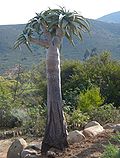Classification System: APG IV
Superregnum: Eukaryota
Regnum: Plantae
Cladus: Angiosperms
Cladus: Monocots
Ordo: Asparagales
Familia: Asphodelaceae
Subfamilia: Asphodeloideae
Genus: Aloidendron
Species: A. barberae – A. dichotomum – A. eminens – A. pillansii – A. ramosissimum – A. sabaeum – A. tongaense
Name
Aloidendron (A.Berger) Klopper & Gideon F.Sm., Phytotaxa 76: 9 (2013)
Type species: Aloidendron barberae (Dyer) Klopper & Gideon F.Sm., Phytotaxa 76: 9 (2013)
Synonyms
Basionym
Aloe sect. Aloidendron A.Berger, Bot. Jahrb. Syst. 36: 56. 1905.
Heterotypic
Aloe sect. Dracoaloe A.Berger, Bot. Jahrb. Syst. 36: 56. 1905.
Type species: Aloe dichotoma Masson
References
Primary references
Grace, O.M., Klopper, R.R., Smith, G.F., Crouch, N.R., Figueiredo, E., Rønsted, N. & Van Wyk, A.E. 2013. A revised generic classification for Aloe (Xanthorrhoeaceae subfam. Asphodeloideae). Phytotaxa 76(1): 7–14. DOI: 10.11646/phytotaxa.76.1.2 Open access ResearchGateReference page.
Additional references
Manning, J.C. Boatwright, J.S., Daru, B.H., Maurin, O. & van der Bank, M. 2014. A molecular phylogeny and generic classification of Asphodelaceae subfamily Alooideae: a final resolution of the prickly issue of polyphyly in the alooids? Systematic Botany 39(1): 55–74. DOI: 10.1600/036364414X678044 ResearchGate Reference page.
Links
Govaerts, R. et al. 2017. Aloidendron in World Checklist of Selected Plant Families. The Board of Trustees of the Royal Botanic Gardens, Kew. Published online. Accessed: 2017 Sept. 11. Reference page.
International Plant Names Index. 2017. Aloidendron. Published online. Accessed: Sept. 11 2017.
Aloidendron is a genus of succulent plants in the subfamily Asphodeloideae.[2] It was split off from the much larger genus Aloe in 2013.[1]
Taxonomy
Phylogenetic studies indicated that several species that were traditionally classed as members of the genus Aloe were genetically distinct and comprised an entirely separate clade. In 2013, the species were accordingly split off as a separate genus, Aloidendron, a decision that was confirmed by Manning et al. in 2014.[3]
Species
As of October 2017, the World Checklist of Selected Plant Families accepts the following species:
| Image | Scientific name | Distribution |
|---|---|---|
 |
Aloidendron barberae (Dyer) Klopper & Gideon F.Sm. | Eastern Cape through the former Transkei, KwaZulu-Natal, Swaziland and Mpumalanga; and northwards to Mozambique and East Africa |
 |
Aloidendron dichotomum (Masson) Klopper & Gideon F.Sm. | north of Keetmanshoop, in Namibia. Northern Cape of South Africa at Gannabos. |
 |
Aloidendron eminens (Reynolds & P.R.O.Bally) Klopper & Gideon F.Sm. | the northern area around Erigavo,Somalia. |
 |
Aloidendron pillansii (L.Guthrie) Klopper & Gideon F.Sm. | Namibia and South Africa |
 |
Aloidendron ramosissimum (Pillans) Klopper & Gideon F.Sm. | between South Africa and Namibia |
 |
Aloidendron sabaeum (Schweinf.) Boatwr. & J.C.Manning | Saudi Arabia and Yemen |
 |
Aloidendron tongaense (van Jaarsv.) Klopper & Gideon F.Sm. | KwaZulu-Natal, at the border between Mozambique and South Africa |
References
"Aloidendron", World Checklist of Selected Plant Families, Royal Botanic Gardens, Kew, retrieved 2017-10-15
"Aloidendron (A.Berger) Klopper & Gideon F.Sm". Plants of the World Online. The Trustees of the Royal Botanic Gardens, Kew. n.d. Retrieved 2020-08-22.
Manning, John; Boatwright, James S.; Daru, Barnabas H.; Maurin, Olivier & Bank, Michelle van der (2014), "A Molecular Phylogeny and Generic Classification of Asphodelaceae Subfamily Alooideae: A Final Resolution of the Prickly Issue of Polyphyly in the Alooids?", Systematic Botany, 39 (1): 55–74, doi:10.1600/036364414X678044
Retrieved from "http://en.wikipedia.org/"
All text is available under the terms of the GNU Free Documentation License

